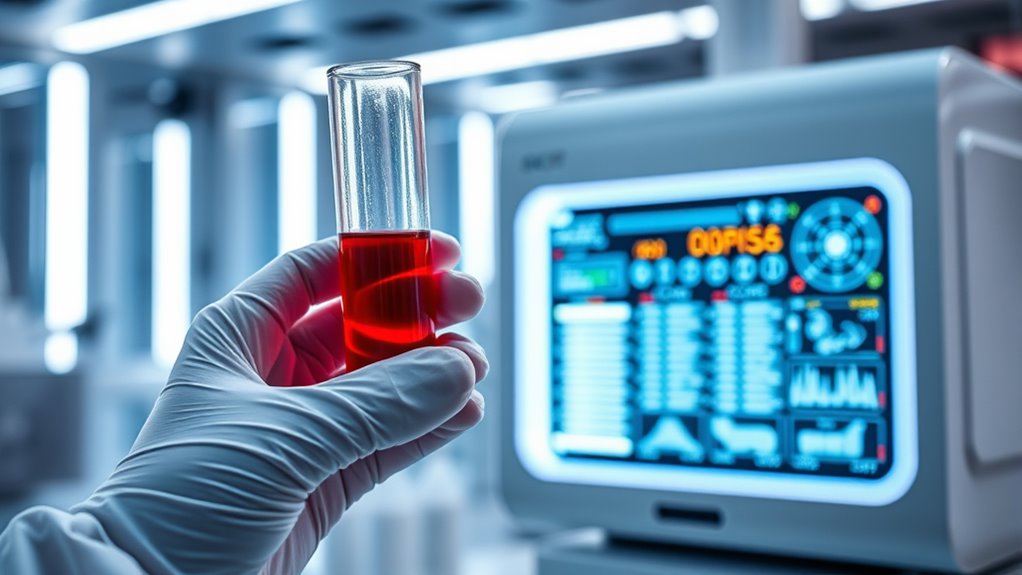Multi-cancer blood tests are revolutionizing early detection by using advanced technologies like genomics, proteomics, and metabolomics to identify multiple cancers from a simple blood sample. These tests analyze circulating tumor DNA, cells, and other biomarkers with high accuracy, often aided by AI to improve results. They can detect cancers at earlier stages, sometimes before symptoms appear, potentially saving more lives. If you want to discover how these innovations are shaping future cancer care, explore further.
Key Takeaways
- Multi-cancer blood tests utilize genomic, proteomic, and metabolomic methods for early detection of various cancers.
- Liquid biopsies analyzing ctDNA and CTCs enable minimally invasive, early diagnosis and disease monitoring.
- Integration of multi-omics data and AI enhances diagnostic accuracy and helps overcome biological heterogeneity.
- These tests can detect over 50 cancer types with high specificity, improving early intervention opportunities.
- They are transforming cancer management by enabling earlier detection, especially for cancers lacking traditional screening tools.

Have you ever wondered how blood tests could revolutionize cancer detection? Thanks to advancements in multi-cancer blood testing technologies, early diagnosis is becoming more feasible and less invasive than ever before. These tests leverage various cutting-edge methods, including genomic, transcriptomic, proteomic, and metabolomic technologies, to identify cancer signals in the blood long before symptoms appear. For example, genomic techniques like next-generation sequencing (NGS) and single-cell genomics can detect minute cancer-related genetic changes with high sensitivity. However, they tend to be costly and require complex interpretation, which can slow down widespread use. On the other hand, transcriptomic approaches such as RNA sequencing help identify unique cancer signatures, aiding in treatment decisions. Still, integrating and interpreting this data remains challenging, limiting immediate clinical application. Proteomic technologies focus on analyzing proteins through mass spectrometry and profiling, aiming to find minimally invasive biomarkers. These methods are promising but face issues like variability and technical difficulties in quantification that hinder consistency. Metabolomic technologies analyze metabolic changes associated with cancer, offering early diagnostic potential. Yet, they demand sophisticated data analysis and standardized procedures to guarantee reliable results. Liquid biopsies, which examine circulating tumor DNA (ctDNA) and circulating tumor cells (CTCs), are particularly exciting because they provide a simple, minimally invasive way to monitor cancer presence and progression over time. Despite ongoing validation efforts, these approaches have already shown promise in detecting multiple cancer types. The integration of multi-omics data with AI-driven analysis further enhances the potential of these tests by improving accuracy and predictive power. Multi-omics integration platforms, like CancerSEEK, combine data from different biological layers to offer detailed molecular insights, dramatically improving diagnostic accuracy. These platforms face hurdles like biological heterogeneity and the significant computational power needed to analyze complex data. Artificial intelligence (AI) further enhances these efforts by improving biomarker discovery and predictive modeling, but it requires rigorous validation and careful handling of privacy concerns. Sensitivity and specificity vary across different tests. For example, the TruCheck test achieved 90% sensitivity and 96.4% specificity in large cohorts, detecting circulating tumor cells and ctDNA effectively. Still, early-stage cancers can be more elusive, with some tests detecting as low as 12.7% sensitivity for early stages. High specificity rates, often above 95%, are critical to minimizing false positives, especially in screening asymptomatic populations. These tests can detect over 50 types of cancers, including hard-to-detect ones like pancreatic or ovarian cancer, which lack effective screening tools. By analyzing cell-free DNA, circulating tumor cells, proteins, and metabolites, these blood tests aim to catch cancers early, dramatically changing the landscape of cancer management and improving patient outcomes.
Frequently Asked Questions
How Accurate Are Multi-Cancer Blood Tests Across Different Cancer Types?
You want to know how accurate multi-cancer blood tests are across different cancer types. These tests generally predict the primary cancer origin with about 89% accuracy, performing best for lung, colorectal, breast, and ovarian cancers. Sensitivity varies by cancer, from as high as 96% for esophageal-gastric cancers to 21% for prostate. While they’re effective in detecting late-stage cancers, early-stage detection remains a challenge, and accuracy can differ depending on the cancer type.
Are Multi-Cancer Blood Tests Covered by Insurance Plans?
You might wonder if multi-cancer blood tests are covered by insurance plans. Currently, most private insurers don’t cover these tests, and patients often pay out-of-pocket. Some Medicare Advantage plans offer limited coverage, but full Medicare coverage requires FDA approval and legislative action. As these tests are still evolving, coverage depends on regulatory status and clinical validation, which means widespread insurance reimbursement isn’t yet guaranteed.
What Are the Potential False-Positive Rates for These Tests?
Have you ever wondered how often false alarms happen with new cancer tests? With multi-cancer blood tests like Galleri, the false-positive rate is remarkably low—around 0.5%. This means that out of 200 people tested, only one might get a false positive. These tests aim to catch cancer early while minimizing unnecessary follow-ups, making them a promising tool for early detection with fewer false alarms than multiple single-cancer tests.
Can These Tests Detect Cancer Before Any Symptoms Appear?
You wonder if these blood tests can spot cancer before symptoms show up. The good news is that they can detect cancer signals in asymptomatic individuals by identifying tumor biomarkers. Their high sensitivity, especially at early stages, means you have a better chance of catching cancer early, when treatment is most effective. While not perfect, these tests markedly improve early detection, offering hope for better outcomes before symptoms even arise.
How Do Multi-Cancer Blood Tests Compare to Traditional Screening Methods?
You compare multi-cancer blood tests to traditional screening methods by noting that MCEDs detect over 50 cancers with a single blood sample, offering less invasive and more accessible screening. While traditional tests target specific organs and have higher sensitivities for certain cancers, MCEDs can identify multiple cancers early, including rare types. However, they face challenges like false positives and require further validation to confirm their impact on mortality reduction.
Conclusion
Imagine a future where your blood becomes a sentinel, quietly warning you of hidden dangers lurking beneath the surface. Multi-cancer blood tests act like a lighthouse, guiding you safely through the storm of uncertainty toward early detection and hope. With each drop, you hold the power to catch cancer early, turning the tide in your favor. This revolution transforms your blood into a beacon of life, illuminating a path to healthier, brighter days ahead.










